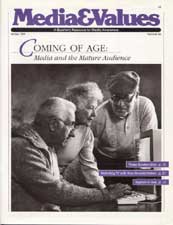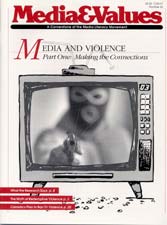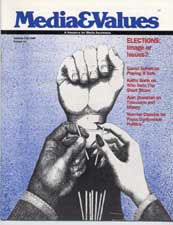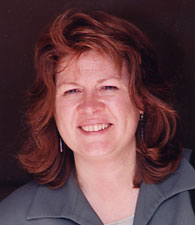Reading Room Search
Go here for complete Reading Room Article Index
Displaying 551 - 575 of 607
Stores have always put up Valentine's Day promotions as soon as the Christmas promotions come down. But now, it's the Garfield Valentines that come out as soon as the Garfield Christmas items are put away, and Muppet Valentines that replace Muppet Christmas gear. In case you miraculously escaped a Christmas tainted with Big Bird Stockings, Care Bear tree ornaments, and Smurf jammies, you can't relax yet, because your child will be bombarded with those same smiling faces on Valentine goodies as he was for Thanksgiving, Halloween, and back-to-school.
It doesn't stop at holidays either.... Read More

Three things sell newspapers and boost ratings: sex, suffering and silver (money). This at least is the typical formula many news organizations use in planning their offerings. While the decisions of editorial departments should in no way be influenced by what is happening on the advertising and the commercial sides of the news business, this gap has shrunk or evaporated in many news organizations, both print and electronic.
With the decline of family publishing empires, increased mechanization in production techniques and the rising concentration and internationalization of the news... Read More

Bombarded by media images of glamorous jobs with big rewards and little or no effort, young people may conclude work is always exciting and extravagant lifestyles are easy to achieve. Class or family discussion of the following questions can help both young people and adults focus on the contrast between reality and the work world of television.
Discuss what favorite characters do for a living, how much time they spend working and how their work or labor is portrayed. What do their annual salaries appear to be? Could real people earning such salaries afford the lifestyle (furniture,... Read More

Television's portrayal of the work world may have changed over the years, but the message absorbed by many children and teenagers, particularly those who watch a lot of television, is not always a positive or realistic one.
The first thing that should strike a viewer as odd about professional life on television is that very few people do any real work at all. Instead, we see lawyers, doctors, police officers, private investigators, and business tycoons spending a great deal of time talking to one another - generally socializing on the job.
When they are working, we often get to see only the... Read More
The Empire Strikes: Mergers in the Media World
What happens when fewer and fewer owners take over more and more media channels. An overview of the author's ground-breaking book, The Media Monopoly. By Ben Bagdikian
If all major media in the United States - every daily newspaper, magazine, broadcasting station, book publishing house and motion picture studio - were controlled by one "czar," the American public would have reason to fear for its democracy. The danger is not that this single controller would necessarily be evil, though this kind of extravagant power has a grim history. Whether evil or benevolent, centralized control over information, be it governmental or private, is incompatible with freedom. Modern democracies need a choice of politics and ideas, and that choice requires access to... Read More

The late mythologist and philosopher Joseph Campbell once noted that in medieval times the approach to a city was dominated by the spires of its cathedral and castle. Nowadays, the soaring towers of commerce are the first things to strike the eye.
People build their lives around these towers. Communities take shape. Work skills are learned, social relationships are formed and personal aspirations are molded. A dense matrix of values grows up around and intertwines with these modern temples.
Perhaps their... Read More

Like many nursing home patients, 90 year-old Trudy Smith resented being placed in The Center for the Aging in Washington D.C. She complained that her sister had abandoned her and she felt unloved and unwanted. At least she did until her sister and other family members joined the center's Visiting Through Video (V-TV) program. Working through the experimental program they created a short video tape about Trudy's past life and their feelings for her. Featured in the video were remembrances of family activities and trips and Trudy's favorite hobby: bread-making. Watching the tape over and... Read More
Sex on TV: Do All Kids See the Same Show?
Using interviews and diaries, researchers learn how young girls evaluate media sexuality. By Kim Walsh Childers & Jane Brown
On sex in soap operas compared to real life: "They don't ever seem to think ahead. They just decide that [sex] is what they want to do, and in a soap opera it's not really going to hurt them anyway." - 15 year-old girl
Media sex has come a long way from the days of Ozzie and Harriett's twin beds. Although the taboo against simulated sex on television still holds, couples are frequently seen in bed during daytime dramas and on late evening shows. And sex is talked about a lot; at least one or two references to sexual intercourse occur in an average hour of programming, according... Read More
Lifeline or Leisure?: TV's Role in the Lives of the Elderly
Research Shows TV Plays Varied Roles in Seniors' Lives By Kathaleen Reid
In living rooms across the nation, we are told, listless seniors sit staring at TVs, trapped by loneliness and the fear that the world outside is mean and devoid of compassion. The stereotype is sad, but it is also one that is widely accepted as another sign of society's disintegration. A decade ago, cartoonist Jules Feiffer drew a bead on the problem, penning a strip in which an older man sits talking to his TV. "No one loves me," he says, and the TV responds, "I love you." Each time the man complains that he has no one to take care of him, to give to him, or to be his friend, the TV... Read More

To older people the world we thought we knew seems to be continually disappearing and electronic media are a large part of the new vistas that continually emerge. In contrast to the relative simplicity of our own childhood, many of us view the media playthings surrounding our grandchildren with awe. VCR cassettes are a long way from crystal radio sets with earphones!
Even more astonishing is our grandchildren's facility with today's hardware and software. My four-year-old grandniece cannot yet read... Read More

Critics of television violence research note that media violence experts measure television violence quite differently. George Gerbner of the University of Pennsylvania's Annenberg School for Communication measures most acts of violence equally, whether an accident or intentional. The National Coalition on Television Violence "weighs" violence so a minor act like shoving counts as one-third of an act of violence while murder counts as one and two-thirds an act of violence. Judge for yourself by developing your own definition of media violence and putting it to the test:
First, develop... Read More

Politicians are generally delivered to us through the images of the media. To help you as an individual political campaign watcher or as an activity for a group in your church or synagogue, conduct an analysis of your values versus those of the political candidates, whether on the national, state, or local level. Compile two lists:
Attributes that you see in politicians according to their media images. For example:
acting as a father figure
representing old guard values
riding on the coattails of the president
projecting the image of a family man/woman
conveying the potential for... Read More

The founder of the Center for Media Literacy told local educators Monday that there are many benefits to living in the electronic age.
"My father is all of a sudden connected with all of his World War II buddies," said Elizabeth Thoman, president of the Los Angeles-based organization.
Of course, there is a however. "At the same time, that's problematic," she said. "With the accessibility, we're inundated with a lot of information that's irrelevant."
The challenge for parents in such an environment is to create a healthy balance from an onslaught of media messages. "Kids need skills to... Read More
The Center for Media Literacy (CML) is pleased and proud to introduce its new corporate identity, designed and generously contributed by James Robie Design Associates.
This identity reflects the Center’s mission for the 21st Century: Educating children and adults for living and learning in a global media world. "We are thrilled to have this opportunity to mark a new era in the development of the media literacy field," said Elizabeth Thoman, CML’s Founder and President. "It is now time for media literacy to take its place in our educational and media institutions, as well as in the minds... Read More
Teaching our Children to "Do For Themselves"
Remarks at CML’s First Annual Fundraising Breakfast (November 14, 2000) By Elizabeth Thoman
Like many of you, I watched with great joy Sunday night the remake of The Miracle Worker, the moving story of how Annie Sullivan helped the blind and deaf 7-year-old Helen Keller learn to "speak" with her hands. Eventually Helen was able to both "see" and "hear" — and thus make sense of the world around her.
Annie, of course, was a wonderful teacher and she knew that the key to unlocking Helen’s brilliant mind was language. "Language" she says to Captain and Mrs. Keller when she first... Read More
Media Violence Not a Simple Issue
When Hollywood actor Daniel Stern (Home Alone) decided kids need to learn how movies and TV were made, he called L.A.'s Center for Media Literacy. Now he's hooked on teaching. And some lucky 9th graders are learning to carefully evaluate what they watch, see and read. By Pat Nason, UPI Hollywood Reporter
LOS ANGELES, Sept. 27 (UPI) — As top Hollywood studio officials prepared to testify on Capitol Hill about marketing violent images to young consumers, they were facing tough questions from members of the Senate Commerce Committee - several of whom could be described as skeptical, suspicious, angry or downright hostile when it comes to Hollywood.
The hearings were called in response to a report by the Federal Trade Commission... Read More
CML Founder Receives Award for Lifetime Achievement
University of Dayton Honors Elizabeth Thoman June 26, 2000 DAYTON, Ohio — From the try-it-at-home science experiments of Bill Nye the Science Guy to the sophisticated marketing tie-ins between fast food restaurants and the latest Hollywood summer blockbuster, children today are immersed in media messages.
Teaching them — and adults as well — to decipher substance from selling point is the mission of Elizabeth Thoman, CHM, founder and president of the Center for Media Literacy in Los Angeles... Read More
Daniel Kane Award Given to Media Literacy Pioneer
In her speech following the award, Liz reviewed the 25-year history of media literacy in the United States and called for the help from university schools of education to prepare teachers at every grade level. "Media literacy is a basic competency in today's world. All children should have the skills needed to participate as informed citizens and educated adults in the 21st century media culture." With children spending 38 hours per week — almost a full adult work week — using and watching the various forms of media that make up modern life, giving them the skills to separate the substance from the selling point is vital, says a pioneering voice in the U.S. media literacy movement.
Sister Elizabeth Thoman, CHM, founder and president of the Center for Media Literacy in Los Angeles, addressed the challenges of modern media... Read More
Video Basics and Production Projects for the Classroom
A veteran filmmaker shares some secrets to success. By Andrew Garrison Film has proven its power to engage us for over 100 years; radio for over 70 years, television for 50, and computer media, the new kid on the block, is proliferating faster than its predecessors. Students watch it all. Integrating media production in your curriculum can help you find new access to students and help them find new access to the material. Media production engages and excites; it leads to unexpected discoveries, increased... Read More
Seven Great Debates in the Media Literacy Movement -- Circa 2001
Noting the differing ideologies among the diverse community of media educators, organizers and activists, Renee Hobbs calls for all of us in media literacy to "cast our ballot" on these debates to help build a movement in which all points of view are heard, respected and accommodated. By Renee Hobbs, EdD In recent years, there has been an explosion of educational practices and curriculum resource materials which make use of the broad concept of "media literacy." Media literacy has been defined as the ability to access, analyze, evaluate and communicate messages in a wide variety of forms (Aspen Institute, 1993), an expansion of traditional conceptualizations of literacy to include a wide range of symbolic forms. It is a term used by a growing number of scholars and educators to refer to the process of critically analyzing and learning to create one's own messages-- in print, audio,... Read More
Letter to Network Challenges Image of Nuns as Crime Victims
Classic letter is model for expressing a different point of view.
Editor's Note: The following letter, after being sent to ABC-TV, was published in the Viewer's Guide Workbook for the Television Awareness Training adult education program, as an outstanding model for writing a letter of complaint to a network The letter writer did receive a polite reply from ABC; the organization she then represented no longer exists.
March 31, 1976
Mr. Frederick Pierce
President, ABC Television Network
1330 Avenue of the Americas
New York, New York 10019
Dear Mr. Pierce:
The National Sisters Communication Service, a national liaison and resource office for 140,000... Read More
Media Education in the Year 2000: Directions and Challenges
As we enter the new millennium, a media literacy pioneer reflects on the challenges we face. By Kathleen Tyner
The challenges facing media education in the year 2000 are the same challenges facing school change efforts. These include details about teaching and learning such as teacher preparation, the content and assessment of the curriculum, restructuring of the school day to accommodate project-based and interdisciplinary work, the availability of resources, the balance between analysis and practice, and identifying the most beneficial teaching approaches. Challenges to the inclusion of media education in the existing curriculum also encompass broader issues such as the boundaries of information... Read More
Sample Editing Portfolio
Video editing is a learned skill; here's how to practice. Developed by Steve Goodman, Educational Video Center, New York City Editing is more than just pushing buttons. It means telling a story with images and sounds. In this portfolio collect at least three of the following:
A group of still images, arranged in a sequence that tells a story.
Storyboards for your practice project or final tape.
A segment of videotape (rough or final) from your group's work.
Any videotape from other producers that give you editing ideas for your own work.
Other visual art (charts, graphics, titles), original or otherwise, that you have used in your piece.
Music or sound effects you have created for your tape.
Five... Read More
What is "Critical Viewing?"
From the introduction to the 1979 curriculum, Television Literacy: Critical Television Viewing Skills, Module 1 Since the effects of TV viewing can be both positive and negative, the purpose of this module is to help you approach the medium with new-found delight, awe, outrage, interest, and knowledge. If you are aware of the medium's behind-the-scenes realities, you will not be so stunned or manipulated by its messages. You also will be better able to understand its potential benefits in your home, community, and society. As a participant in this course, you will begin to watch TV actively by imagining yourself to be a professional TV writer, director, producer, advertiser, actor - and most... Read More

The following article is from the introduction to the Media Literacy Resource Guide published by the Ontario Ministry of Education in 1989 to guide the implementation of media literacy in language arts in Ontario high schools. The guide was written by members of the Association for Media Literacy / Canada.
Introduction
The teacher's attitude to the mass media and to students as avid media consumers is crucial to the success of any media literacy program. Most students bring to the classroom an enormous amount of information about and experience with the media -- in many cases, far more than... Read More

